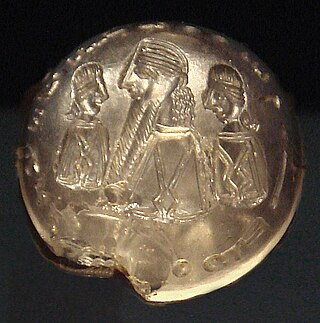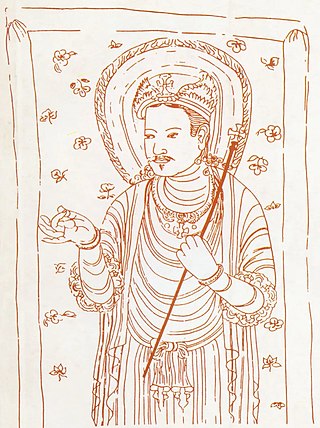
Manichaeism is a formerly major world religion, founded in the 3rd century CE by the Parthian prophet Mani, in the Sasanian Empire.

Mani was an Iranian prophet and the founder of Manichaeism, a religion most prevalent in late antiquity.

The Arzhang, also known as the Book of Pictures, was one of the holy books of Manichaeism. It was written and illustrated by its prophet, Mani, in Syriac, with later reproductions written in Sogdian. It was unique as a sacred text in that it contained numerous pictures designed to portray Manichaean cosmogony, which were regarded as integral to the text.

The Living Gospel was a 3rd-century gnostic gospel written by the Manichaean prophet Mani. It was originally written in Syriac and called the Evangelion, from the Greek εὐαγγέλιον and was one of the seven original scriptures of Manichaeism. A number of fragments are preserved in the Cologne Mani-Codex and on manuscript fragments found in Turfan beginning in 1904. Some Coptic manuscript fragments recovered at Fayyum appear to contain a sort of commentary or homily on the gospel.

The Manichaean script is an abjad-based writing system rooted in the Semitic family of alphabets and associated with the spread of Manichaeism from southwest to central Asia and beyond, beginning in the third century CE. It bears a sibling relationship to early forms of the Pahlavi scripts, both systems having developed from the Imperial Aramaic alphabet, in which the Achaemenid court rendered its particular, official dialect of Aramaic. Unlike Pahlavi, the Manichaean script reveals influences from the Sogdian alphabet, which in turn descends from the Syriac branch of Aramaic. The Manichaean script is so named because Manichaean texts attribute its design to Mani himself. Middle Persian is written with this alphabet.
The Shabuhragan, which means "dedicated to Šābuhr", also translated in Chinese as the Chinese: 二宗经; pinyin: Èrzōng jīng; lit. 'Text of Two principles' was a sacred book of Manichaeism, written by the founder Mani himself, originally in Middle Persian, and dedicated to Shapur I, the contemporary king of the Sasanian Empire. This book is listed as one of the seven treatises of Manichaeism in Arabic historical sources, but it is not among the seven treatises in the Manichaean account itself. The book was designed to present to Shapur an outline of Mani's new religion, which united elements from Zoroastrianism, Christianity, and Buddhism.
In theology, divine light is an aspect of divine presence perceived as light during a theophany or vision, or represented as such in allegory or metaphor.
Buddhologist Edward Conze (1966) has proposed that similarities existed between Buddhism and Gnosticism, a term deriving from the name Gnostics, which was given to a number of Christian sects. To the extent that Buddha taught the existence of evil inclinations that remain unconquered, or that require special spiritual knowledge to conquer, Buddhism has also qualified as Gnostic.

Mar Ammo was a 3rd-century Manichean disciple of the prophet Mani. According to Manichaen tradition he spread Manichaeism eastward into Sogdiana during the time period when Mani was living. Mar Ammo is well known as the apostle of the east in Manichean literature nevertheless his exact origins are unknown. His Syriac name may denote that he was Syrian in origin. However, a Parthian origin may also be seen and is mentioned by some scholars, especially due to his outstanding role in establishing the Parthian language as the official language of the eastern Manichean Church, later to be replaced by Sogdian in the sixth century. Furthermore, Mar Ammo is widely regarded as the composer of the Manichaean Parthian hymn-cycles.

Chinese Manichaeism, also known as Monijiao (Chinese: 摩尼教; pinyin: Móníjiào; Wade–Giles: Mo2-ni2 Chiao4; lit. 'religion of Moni') or Mingjiao (Chinese: 明教; pinyin: Míngjiào; Wade–Giles: Ming2-Chiao4; lit. 'religion of light' or 'bright religion'), is the form of Manichaeism transmitted to and currently practiced in China. Chinese Manichaeism rose to prominence during the Tang dynasty and despite frequent persecutions, it has continued long after the other forms of Manichaeism were eradicated in the West. The most complete set of surviving Manichaean writings were written in Chinese sometime before the 9th century and were found in the Mogao Caves among the Dunhuang manuscripts.
The Manichaean Diagram of the Universe is a Yuan dynasty silk painting describing the cosmology of Manichaeism, in other words, the structure of universe according to Manichaean vision. The painting in vivid colours on a silk cloth survives in three parts, whose proper relation to one another and digital reconstruction was published by Zsuzsanna Gulácsi.
Zsuzsanna Gulácsi is a Hungarian-born American historian, art historian of pan-Asiatic religions. She is a professor of art history, Asian studies, and comparative religious studies at Northern Arizona University (NAU). Her teaching covers Early and Eastern Christian art, Islamic art, with special attention to the medium of the illuminated book; as well as late ancient and mediaeval Buddhist art from South, Central, and East Asia.
Manichaean scripture includes nine main books: the Seven Treatises of Manichaeism, all personally written by Mani in Syriac, the Shabuhragan written by Mani in Middle Persian, and the Arzhang, a series of illustrations painted by Mani.

In Manichaeism, Jesus is considered one of the four prophets of the faith, along with Zoroaster, Gautama Buddha and Mani. He is also a "guiding deity" who greets the light bodies of the righteous after their deliverance.

Manichaean Temple Banner Number "MIK Ⅲ 6286" is a Manichaean monastery flag banner collected in Berlin Asian Art Museum, made in the 10th century AD. It was found in Xinjiang Gaochang by a German Turpan expedition team at the beginning of the 20th century. The flag streamer is 45.5 cm long and 16 cm wide, with painted portraits on both sides. It is a funeral streamer dedicated to the deceased Manichae believers.

The three Persian religions, as a medieval Chinese concept, referred to a group of Iranian religions that spread to Tang China. They were recognized and protected under Tang rule, helping them to prosper in China at a time when Sassanid Iran was falling to the early Muslim conquests. The three religious movements identified by the term were Zoroastrianism, the Persian Church, and Manichaeism.

Mani's Parents is a color painting on silk drawn in the coastal areas of southern China during the late Yuan and early Ming dynasties. It is in the collection of the Asian Art Museum of San Francisco, US, and was donated by Ivory Brendage. The title given on the official website of the museum is "Fragment of a Manichaen Mandala".

Manichaeism has a rich tradition of visual art, starting with Mani himself writing the Book of Pictures.

In Manichaeism, Siddartha Gautama is considered one of the four prophets of the faith, along with Zoroaster, Jesus and Mani. Mani believed that the teachings of Gautama Buddha, Zoroaster, and Jesus were incomplete, and that his revelations were for the entire world, calling his teachings the "Religion of Light".












